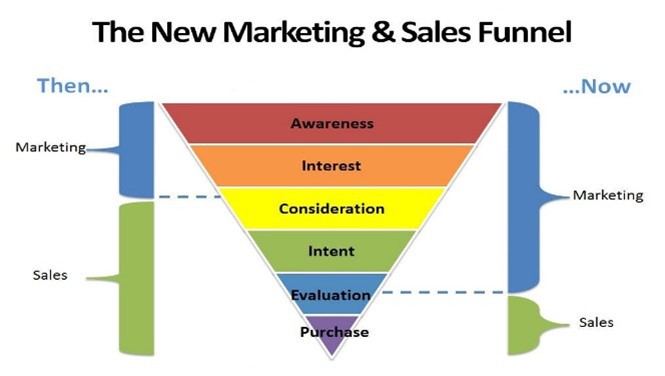
In my experience, it’s not uncommon for small to medium B2B clients to blur the line between sales and marketing. That’s understandable because many of these clients are often adding a traditional sales function to their businesses for the first time and have limited experience with both sales and marketing.
They may have hired a salesperson or used a marketing company in the past, but now they are at a stage where they need to build a proactive sales approach that needs to be supported by a marketing strategy.
While it is important to have both, and both go hand-in-hand, sales and marketing are two distinct functions that play key roles in driving business growth and generating revenue. So, let’s explore what is sales and what is marketing.
What Is Marketing?
Marketing definition: often called “top of the funnel” activities, the primary objective of marketing is to create awareness, generate interest, and build relationships with potential customers. I call this the “know, like, and trust” factor.
Marketing activities focus on:
- Understanding the market.
- Identifying target customers.
- Developing strategies to reach and engage them effectively.
Marketing activities include market research, branding, advertising, social media content creation and management, lead generation, and nurturing potential customers who aren’t ready to buy.
Marketing also plays a big factor in establishing the company’s professional reputation and credibility as a supplier.
What Is Sales?
Sales definition: the main objective of sales is to convert leads and prospects into paying customers. Sales is the revenue generation engine.
Sales activities are focused on:
- Direct interactions with customers who need and want what is being sold.
- Understanding the customers’ needs.
- Presenting solutions.
- Negotiating contracts.
- Winning new business.
Where Sales and Marketing Meet
These teams tend to operate in separate silos and take different approaches, but their goal is the same: to attract prospects and convert them to customers in order to generate revenue.
To do this, it’s important for both sales and marketing to have a good understanding of the ideal client profile. The difference is marketing’s approach is wide and shallow, while sales’ focus is narrow and deep.
Sales takes the prospect who already has an interest in the product or service through a defined process, gives them confidence in their decision, and motivates them to pull the trigger on the buy. Sales interacts directly with people while marketing uses messaging more abstractly.
Both sales and marketing are extremely important for business growth. They work together; marketing sets the stage for sales success by creating value propositions and effective messaging that differentiates your products or services in the marketplace and attracts customers.
Here’s an illustration of the sales funnel that shows where marketing starts and where sales starts:

Marketing and sales alignment is beneficial for the overall success of your business. While 87% of sales and marketing leaders say collaboration between sales and marketing is critical for business growth, one in four companies say their sales and marketing teams are either “misaligned” or “rarely aligned.”
Where Does Lead Generation Fit In?
Lead generation activities concentrate on identifying potential customers or prospects who have shown interest in the company’s products or services, and typically, both sales and marketing have lead generation responsibilities.
The marketing team concentrates on attracting and capturing leads through various marketing initiatives. Marketing drives inbound leads from website traffic, social media posts, and advertising.
Sales primarily focuses on converting and closing leads and generating leads through targeted email campaigns, networking, cold calling, following up on inbound inquiries, attending industry events, or through referral programs.
Creating a supportive and reciprocal relationship between marketing and sales can enhance lead generation, improve lead quality, and make it easier for teams to connect with customers.
Investing in building a pro-active sales approach should include not just hiring salespeople but supporting them with a marketing plan that engages your potential customers, creates credibility for your company as a supplier and creates a funnel of future customers who “know, like and trust” you but aren’t ready to buy yet.
Are you ready to learn more about how to generate more revenues for your company by changing your sales approach? Contact me to learn how a change in approach can ignite growth for your business.
